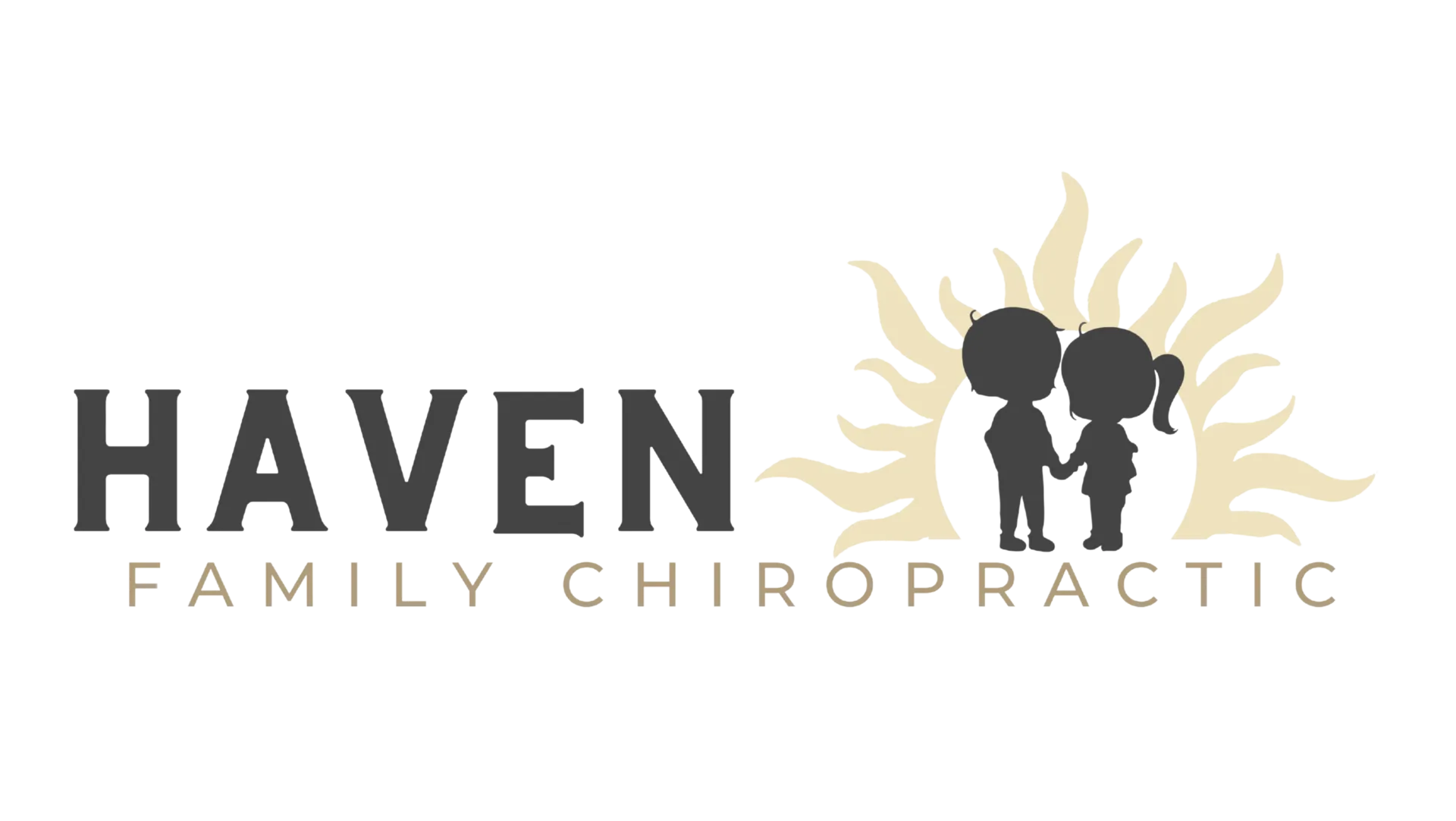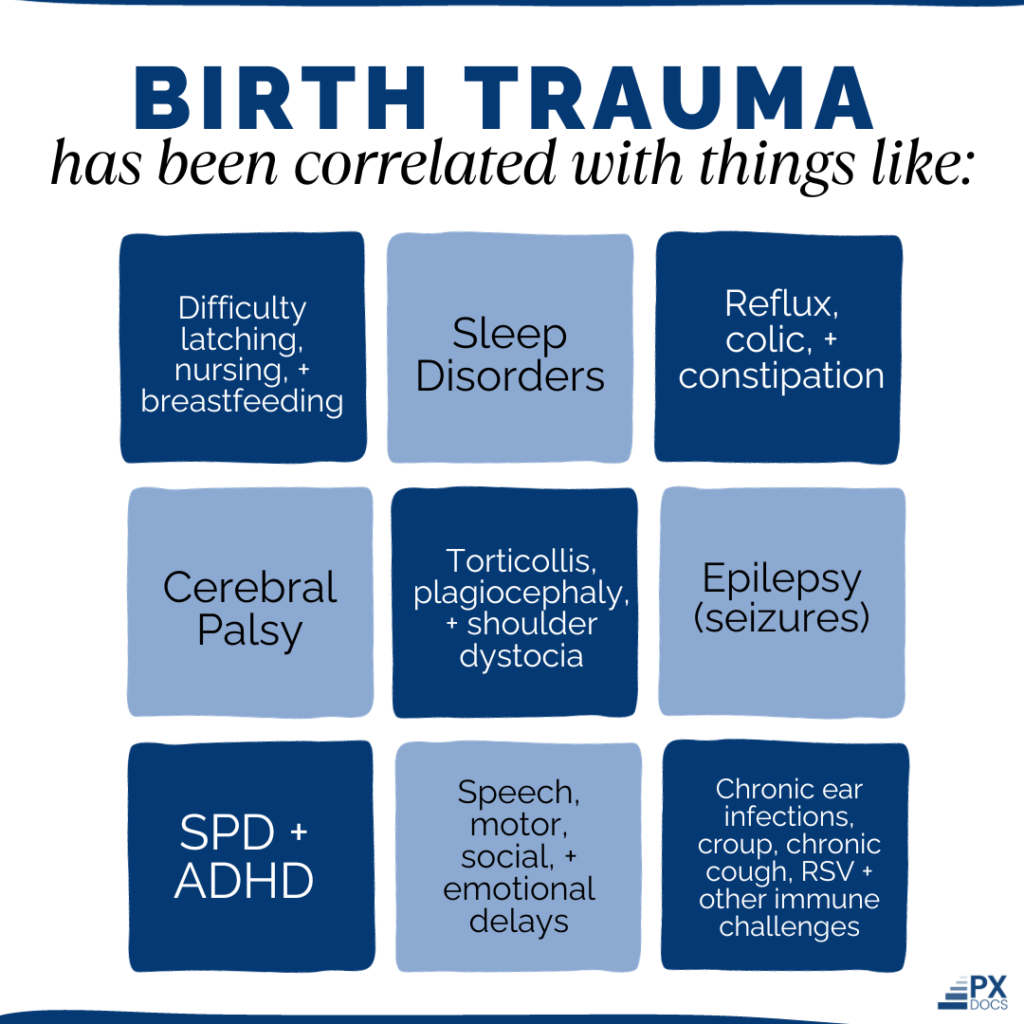WHAT IS BIRTH TRAUMA?
Birth trauma is any trauma or injury, most commonly physical, that happens during the labor and delivery process and often leads to lifelong health challenges, disabilities, and neurological problems for the child.
In our opinion, birth trauma is the single most overlooked causative factor of the massive rise in chronic illness in our kids today. Of course, it leads to short-term challenges like lowered APGAR scores and difficulty nursing, but the real issue is the long-term health and neurological development consequences of birth trauma.
Again and again, we see birth trauma correlated with things like:
- Difficulty latching, nursing, breastfeeding
- Sleep disturbances and disorders
- Reflux, colic, constipation
- Torticollis, plagiocephaly, shoulder dystocia, etc.
- Cerebral palsy
- Epilepsy (seizures)
- Autism, sensory processing disorders, ADHD, and other neurodevelopmental challenges
- Speech, motor, social, and emotional delays, and disorders
- Chronic ear infections, croup, chronic cough, RSV, and other immune challenges
WHAT CAUSES BIRTH TRAUMA?
Birth trauma is most commonly physical in nature. It can come from all the various forms of birth intervention like epidurals, inductions, forceps or vacuum extraction, fetal cord monitoring, and c-section deliveries.
Other common risk factors that may lead to birth trauma or birth injury include:
- The position of the baby
- High levels of medical intervention
- A large baby
- Lengthy or very short painful labor
- An unusual or small-shaped pelvis
Additionally, it’s important to note that birth trauma can vary significantly in severity. Most birth trauma cases go completely undetected and unnoticed by the traditional medical team.
Birth can be extremely traumatic for both mother and baby, yet documented and described as “normal” and ordinary. Sadly in today’s world, instances like birth trauma have to go dramatically wrong to get the attention of the traditional medical system.
To keep it quite simple, the longer labor and delivery go on, and the more intervention starts to stack up, the more likely birth trauma will occur.
WHAT ARE THE EFFECTS OF BIRTH TRAUMA?
As listed above, the negative health effects of birth trauma on the child are far-reaching and can be connected to almost every pediatric health condition.
The reason for this is quite simple to understand – the system most negatively affected by physical (and toxic) birth trauma is the central or autonomic nervous system. And the nervous system controls and coordinates every other tissue, organ, and cell in the body.
When the function of this system is altered and thrown off course right in the very first moments of life from birth trauma, it creates a condition known as dysautonomia.
Nerding out just a bit more, the real key to all of these early and later life health challenges are tied to a very important nerve called the vagus nerve. The Vagus Nerve is responsible for coordinating our heart rate, breathing, digestion, immune function, social and emotional regulation, and so much more.
The Vagus Nerve is most easily injured via birth trauma simply because of its anatomical location.
This vitally important nerve originates (comes from) the lower brainstem area and then makes its way down through the cervical spine (neck) and all the way into the thorax and abdomen. This is why it’s long been called the “wandering” nerve.
Perhaps more appropriately, we call it the “Air Traffic Control” or “Operating System” nerve. It truly does need to be at 100% function for our children to have 100% health throughout life.
This physical injury to the Vagus Nerve, brainstem, and other areas of the nervous system via birth trauma is what Pediatric Chiropractors call a subluxation.
GET HELP NOW
If you suspect that some or all of your child’s health challenges are possibly related to birth trauma and subluxation, you at least deserve to find out!
As PX Docs, we are the only trained professionals in all of healthcare who really know how to dig deep enough to look for birth trauma and then be able to help.
Learn more about the our Clinical Process and visit our PX Docs Directory here to get your consult scheduled right away with a local PX Doc in your area!
Get connected, schedule a consultation, and give Pediatric Chiropractic a chance to find and care for your child’s birth trauma.
God bless and be well.
ARTICLE SOURCES
Shariatpanahi M, Faramarzi M, Barat S, Farghadani A, Shirafkan H. Prevalence and risk factors of prenatal anxiety disorders: A cross-sectional study. Health Sci Rep. 2023 Aug 21;6(8):e1491. doi: 10.1002/hsr2.1491. PMID: 37614287; PMCID: PMC10442528.
Cerritelli F, Frasch MG, Antonelli MC, Viglione C, Vecchi S, Chiera M, Manzotti A. A Review on the Vagus Nerve and Autonomic Nervous System During Fetal Development: Searching for Critical Windows. Front Neurosci. 2021 Sep 20;15:721605. doi: 10.3389/fnins.2021.721605. PMID: 34616274; PMCID: PMC8488382.
May-Benson TA, Koomar JA, Teasdale A. Incidence of pre-, peri-, and post-natal birth and developmental problems of children with sensory processing disorder and children with autism spectrum disorder. Front Integr Neurosci. 2009 Nov 11;3:31. doi: 10.3389/neuro.07.031.2009. PMID: 19936320; PMCID: PMC2779100.
Zhang T, Sidorchuk A, Sevilla-Cermeño L, et al. Association of Cesarean Delivery With Risk of Neurodevelopmental and Psychiatric Disorders in the Offspring: A Systematic Review and Meta-analysis. JAMA Netw Open. 2019;2(8):e1910236. doi:10.1001/jamanetworkopen.2019.10236
Smallwood M, Sareen A, Baker E, Hannusch R, Kwessi E, Williams T. Increased Risk of Autism Development in Children Whose Mothers Experienced Birth Complications or Received Labor and Delivery Drugs. ASN Neuro. 2016 Aug 9;8(4):1759091416659742. doi: 10.1177/1759091416659742. PMID: 27511908; PMCID: PMC4984315.
Waddington EL, Snider KT, Lockwood MD, Pazdernik VK. Incidence of Somatic Dysfunction in Healthy Newborns. J Am Osteopath Assoc. 2015 Nov;115(11):654-65. doi: 10.7556/jaoa.2015.136. PMID: 26501758.
Curran EA, Dalman C, Kearney PM, Kenny LC, Cryan JF, Dinan TG, Khashan AS. Association Between Obstetric Mode of Delivery and Autism Spectrum Disorder: A Population-Based Sibling Design Study. JAMA Psychiatry. 2015 Sep;72(9):935-42. doi: 10.1001/jamapsychiatry.2015.0846. PMID: 26107922.
Wang, Samuel S.-H & Kloth, Alexander & Badura, Aleksandra. (2014). The Cerebellum, Sensitive Periods, and Autism. Neuron. 83. 518-532. 10.1016/j.neuron.2014.07.016.

